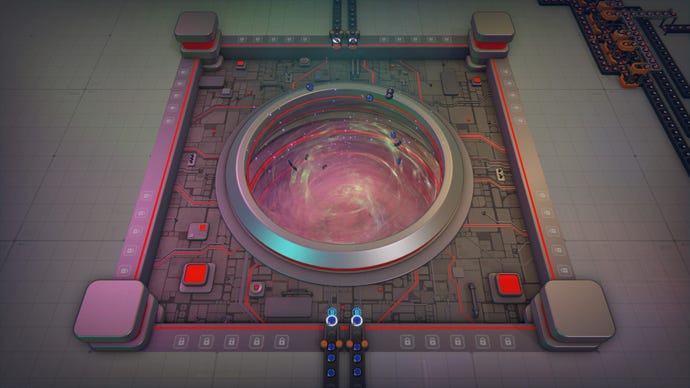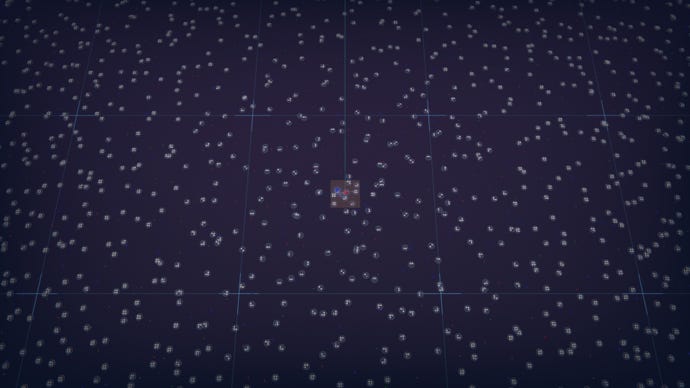Shapez 2's Next Fest demo is the purest catnip for factory game lovers
Join me in drooling over endless lines of conveyor belts
According to Steam, I've spent about 2000 hours playing factory games. Terms like throughput, modularity, and automation are like dog-whistles to me, so when I heard that Shapez 2 was getting a demo for Steam Next Fest this month, I knew my weekend plans were instantly sorted. Well, here we are in the new week. I've finished the Shapez 2 demo twice and logged 10 hours into the game. I see conveyor belts of circles and squares behind my eyelids and the reward system of my brain has been well and truly hijacked. The only way I can continue to do my job effectively is by making my job be about Shapez 2. So here I am.
Shapez 2 knows exactly what it needs to be. It's what developers Tobspr are calling a "pure" factory game, which means there are no enemies to fight, and all the factory buildings and belts you place down are entirely free. It's simply about taking simple shapes, cutting them up, rotating them, and stitching them together again into more complex shapes which you then feed into the big shape-hungry portal at the centre of the map.

If you played Shapez 1, it will all be very familiar to you. The main difference is that Shapez 2 is entirely 3D, and aside from the obvious added complexity of having multiple levels of belts, it means everything looks about 8000% more gorgeous. But it's not just that. Key info such as belt throughput and ideal ratios is much more freely accessible. The controls are more intuitive, too, particularly when placing down conveyor belts - which make up a good 75% of everything you'll ever place, so it's a damn good thing they got it so spot on.
Shapez 2's animation also does a lot of the heavy lifting in making everything feel as satisfying as possible. Watching the cutters neatly bisect and re-organise shapes, or seeing the belt elevators scoop items up and down like bike pedals, is just sublime. The design throughout is exceptional, and stopping to zoom in on a section of my factory at work was just a great big 14-gauge needleful of serotonin to the brain.
The demo is organised by a series of missions displayed in the top-left. There are big main missions, which unlock new building types upon completion, and smaller "suggestion" objectives, which tend to improve the speed of belts and buildings. Both types of missions ask for certain numbers of specific shapes to be delivered to the central portal. An early example might be a shape that's half-circle and half-square, so you have to belt in some circles and squares, cut them up, and stitch them together. Nice and easy. But towards the end of the demo, it starts asking for Frankensteinian multi-coloured shapes, stacked atop one another in dauntingly pleasing patterns.

As the demand for more complex shapes increased, I had to expand beyond the central starting platform that housed the portal and my first few rudimentary factories. That's the other masterstoke of Shapez 2. Instead of just being an endless plain of land like in Shapez 1, everything is untraversable space until you expand outwards by placing new platforms. These platforms are limited in size, too, requiring players to create space-saving designs that take in a shape and do one particular thing to it, for example, before outputting it to a neighbouring platform, which does another particular thing, and so on. Each platform is designed for you to make modular factory blocks that act as macrocosms of the individual cutter and rotator buildings you were placing down at the start of the demo, massively opening up the game's scope and building possibilities in the process.
One other thing I really liked was Shapez 2's Blueprint Points. These are a kind of perpetual side-mission in the demo, earned by delivering more complex types of shapes (the more complex the shape, the more points you get), and spent on essentially copy-pasting sections of your factory elsewhere, reducing the manual labour of placing everything down tile by tile. Blueprints aren't new, of course. They're a staple of the genre. But I really like the decision to tie it to earning points. Given the lack of any building costs, it would feel a bit cheap to just be able to CTRL+C and CTRL+V huge sections of factory for free. But with blueprint points, you have to work towards that ability with a regular influx of shapes, and it gives you another nice avenue of progression and strategy besides completing the main missions.


I do wish the demo challenged me a bit more. Unlike in Shapez 1, the portal will accept the right shape in any orientation, which feels odd in a game that's so hyperfocused on precision with its shapes, and I'm still not sure about all your building costs being free, either. It's convenient, but it also means there's less incentive to be efficient. The platforms may help with this, of course, but even in the demo it's very easy to circumvent this, as I simply had more platforms than I knew what to do with. Convenience is nice, but removing all limits isn't necessarily always the most enjoyable thing.

I think Shapez 2's long-term success will come down to how ambitious it ends up being. I had a scroll through the tech tree beyond the point where the demo ends, and I saw a few very cool-sounding features - trains, colour mixing, and vortex technology (whatever that is) - but I'm mostly hoping for at least one or two more basic shape types. At the moment there's only the circle, square, star, and windmill shapes, and everything is built out of those four. I know that the complexity comes from the layering and colouring of those shapes, but still. What I wouldn't give for a clover, or a diamond, or a donut!
Despite that, the demo left me aching for more. Which probably means it was exactly the right length. I spent a languorous seven hours beating it the first time, but that was down to me deliberately scaling up my production to silly levels. I played the demo again afterwards, and finished it in 90 minutes. So it's really dependent on how you decide to play. Still, everything I've seen looks very promising indeed, and here's hoping that when Shapez 2 releases into early access this year, it will turn the holy trinity of factory games (Factorio, Satisfactory, and Dyson Sphere Program) into a quartet.









